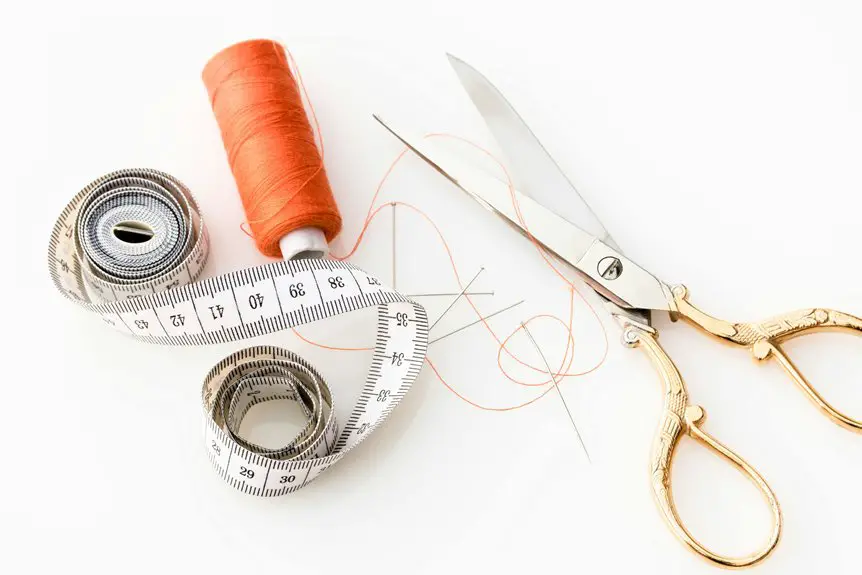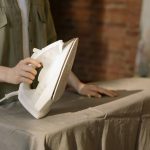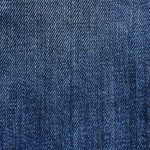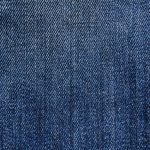To sew scuba fabric, use a ballpoint or stretch needle (80/12 or 90/14) and polyester thread for durability and stretch. Cut carefully with sharp scissors on a flat surface, avoiding pre-washing. Adjust your machine to a medium stitch length with slightly lowered tension to prevent puckering. Sew slowly and use a walking foot for even feeding. Fold hems twice and press gently with low heat. Follow these tips to keep your seams smooth and sturdy, and discover more techniques to perfect your project.
Table of Contents
Key Takeaways
- Use a ballpoint or stretch needle (80/12 or 90/14) and polyester thread for stitch durability and fabric protection.
- Cut fabric on a flat surface with sharp scissors or rotary cutter to maintain the smooth surface and avoid creases.
- Sew with a medium stitch length, lower upper thread tension, and use stretch or narrow zigzag stitches to prevent puckering.
- Employ a walking foot or Teflon foot for even feeding and sew slowly to avoid skipped stitches.
- Fold hems twice by ½ inch, press gently with low heat and a pressing cloth to neatly encase raw edges without damage.
Understanding the Properties of Scuba Fabric
Scuba fabric is a thick, stretchy material that offers excellent durability and a smooth finish. When you work with it, you’ll notice its neoprene-like quality gives your projects structure without being stiff.
Scuba fabric combines durability with a smooth, neoprene-like stretch for structured yet comfortable projects.
Its slight stretch allows for comfortable wear and makes it forgiving when sewing, but you’ll want to avoid overstretching to keep seams intact. This fabric resists wrinkles and water, making it perfect for both fashion and functional items.
It’s also double-knit, so both sides look clean, which means you won’t have to worry about lining your garments. Keep in mind, because it’s thick, it can be tricky to sew through multiple layers, so maintaining even tension is key.
Understanding these properties helps you handle scuba fabric confidently for your next project.
Essential Tools and Materials for Sewing Scuba
Getting the right tools and materials makes sewing thick, stretchy fabrics much easier.
You’ll need a heavy-duty sewing machine needle, preferably a size 90/14 or 100/16, to pierce scuba fabric without skipping stitches. Use polyester or nylon thread for durability and stretch. A walking foot attachment helps feed the fabric evenly, preventing shifting or puckering.
Sharp, high-quality scissors or a rotary cutter guarantee clean cuts without fraying. Don’t forget polyester or stretch pins—they hold fabric securely without damaging it. A ballpoint or stretch sewing machine needle prevents fabric runs.
Finally, have a seam ripper handy for fixing mistakes, and a clear ruler or measuring tape to keep your cuts precise. These essentials set you up for smooth, professional results when sewing scuba fabric.
Preparing and Cutting Scuba Fabric
Before you start sewing, make sure to pre-wash your scuba fabric to prevent shrinkage later.
Handle it gently to avoid stretching, and use sharp scissors or a rotary cutter for clean, precise cuts.
These steps will help you achieve the best results when working with this unique material.
Pre-washing and Handling
Although many fabrics benefit from pre-washing, you shouldn’t wash scuba fabric before cutting because it can lose its shape and texture.
Instead, handle it gently to maintain its smooth surface and slight stretch. Avoid stretching or pulling the fabric unnecessarily, as this can distort its structure.
When you receive your scuba fabric, let it rest flat to relax any creases from shipping or folding. If you spot any wrinkles, use a low-heat iron with a pressing cloth on top—never press directly on the fabric.
Keep your workspace clean and free of rough surfaces that might snag the material. By treating your scuba fabric with care before sewing, you’ll guarantee your finished garment looks professional and keeps its form.
Cutting Techniques and Tools
Since scuba fabric has a dense, smooth texture and a slight stretch, you’ll need sharp tools and careful techniques to cut it accurately. Use a rotary cutter or very sharp scissors to avoid fraying and jagged edges. Lay the fabric flat on a cutting mat, and avoid folding it to prevent unwanted creases. Pin sparingly or use pattern weights to keep the fabric stable.
Here’s a quick guide to tools and tips:
| Tool | Purpose | Tip |
|---|---|---|
| Rotary Cutter | Smooth, precise cuts | Use with a cutting mat |
| Sharp Scissors | Detailed trimming | Keep blades clean |
| Pattern Weights | Hold fabric in place | Avoid excessive pinning |
Following these guarantees clean, accurate cuts for your scuba fabric projects.
Recommended Sewing Machine Settings
To sew scuba fabric smoothly, you’ll need to choose the right needle type, typically a ballpoint or stretch needle.
Adjust your stitch length to a medium setting to prevent puckering, and fine-tune your tension for balanced seams.
These settings will help you achieve clean, professional results.
Needle Type Selection
When sewing scuba fabric, choosing the right needle type can make all the difference in achieving clean, professional seams. You’ll want to use a ballpoint or stretch needle, typically size 80/12 or 90/14, which can easily penetrate the fabric without causing runs or snags.
Avoid universal needles, as they might damage the fabric’s surface. A stretch needle’s rounded tip slides between the fabric fibers instead of piercing them, preserving the material’s smooth finish.
Make certain your needle is sharp and in good condition—dull needles can lead to skipped stitches or fabric damage. Changing needles regularly during your project guarantees consistent stitch quality.
With the right needle, your sewing machine will handle scuba fabric smoothly, making your project look polished and professional.
Stitch Length Adjustment
After selecting the right needle for your scuba fabric, you’ll want to adjust your machine’s stitch length to complement the material’s thickness and stretch. Using too short a stitch can cause puckering, while too long may weaken seams. Aim for a balanced stitch length to maintain fabric integrity and flexibility.
| Fabric Thickness | Recommended Stitch Length (mm) |
|---|---|
| Thin (1-2 mm) | 2.5 – 3.0 |
| Medium (3-4 mm) | 3.0 – 3.5 |
| Thick (5+ mm) | 3.5 – 4.0 |
This adjustment guarantees your seams hold without restricting the scuba fabric’s natural stretch. Test on scraps before sewing your final piece.
Tension Settings Tips
Although adjusting stitch length is important, dialing in the correct tension settings plays an equally crucial role in sewing scuba fabric smoothly. You’ll want to lower your machine’s upper thread tension slightly to prevent puckering or stretched seams.
Start by setting the tension dial a notch or two below your usual setting. Always test on a fabric scrap first to see if the stitches lay flat without pulling or bunching. If the stitches look loose or loops form on the underside, increase the tension gradually. Conversely, if the fabric puckers, reduce tension a bit more.
Techniques for Sewing Seams and Hems
Mastering techniques for sewing seams and hems on scuba fabric guarantees your project holds together smoothly and looks polished.
Start by using a stretch stitch or a narrow zigzag stitch to maintain the fabric’s flexibility. Sew slowly to avoid skipped stitches, and always test on a scrap piece first.
When creating seams, use a walking foot or a Teflon foot to help feed the thick fabric evenly through your machine.
For hems, fold the edge twice—about ½ inch each time—to encase the raw edge neatly and prevent stretching out.
Press your hems gently with a low-heat iron and a pressing cloth to avoid damaging the fabric.
These precise steps will make certain strong, clean seams and hems that complement scuba fabric’s structure.
Tips for Finishing and Caring for Scuba Garments
When you finish sewing your scuba garment, proper finishing and care guarantee it stays in great shape. Use a serger or zigzag stitch to finish seams neatly and prevent fraying. Press seams gently with a low-heat iron and a pressing cloth to avoid damaging the fabric. When washing, turn the garment inside out and use cold water on a gentle cycle. Avoid bleach and fabric softeners, as they can break down the fabric. Hang or lay flat to dry, steering clear of direct sunlight to preserve color and elasticity.
| Tip | Reason |
|---|---|
| Use a serger or zigzag | Prevents seam fraying |
| Press with low heat | Protects fabric texture |
| Wash inside out, cold | Maintains fabric integrity |
| Air dry, avoid sunlight | Preserves elasticity and color |
Frequently Asked Questions
Can Scuba Fabric Be Used for Swimwear?
You can definitely use scuba fabric for swimwear; it’s stretchy, durable, and water-resistant. Just remember it’s thicker than typical swim fabrics, so you might want to adjust your pattern and sewing techniques accordingly for comfort and fit.
Is Scuba Fabric Suitable for Upholstery Projects?
Wondering if scuba fabric works for upholstery? It’s thick and durable, so it can handle wear well. You’ll love its smooth finish and stretch, but remember it’s best for light-use furniture, not heavy-duty pieces.
How Does Scuba Fabric Compare to Neoprene?
You’ll find scuba fabric softer and lighter than neoprene, making it better for fashion. Neoprene’s thicker and more durable, ideal for wetsuits. Both stretch well, but scuba feels smoother and less bulky on your skin.
Can You Dye Scuba Fabric at Home?
You can’t just toss scuba fabric into Grandma’s dye bath and expect a masterpiece—it resists like a diva. You’ll need special synthetic fabric dyes and patience to coax vibrant colors from its stubborn surface.
What Are the Environmental Impacts of Scuba Fabric Production?
You’ll find scuba fabric production uses synthetic fibers, which rely on fossil fuels, releasing greenhouse gases. Plus, manufacturing consumes lots of water and energy. So, you should consider these environmental impacts before choosing scuba fabric.
- Using Acetate Sheets for Crafting: A Guide for Scale Models and More - June 24, 2025
- Caring for Vintage: How to Wash and Preserve 1970s Acetate Clothing - June 24, 2025
- Acetate vs. Acrylic Fabric: A Head-to-Head Comparison - June 24, 2025







